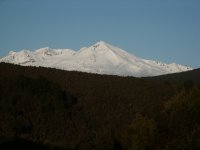




Now we're heading to the crown jewel of the East Cape. As you head north from Gisborne, you spend quite a bit of time inland. Which is frustrating, because you've seen the other side of those hills, and you know that there's some astounding coastline there. But then you come over a hill and there's this amazing azure-turquoise sea. (If there's one thing that I keep being frustrated by on these trips, it's my camera's inability to capture the astoudingly weird and beautiful colors of the lakes, rivers, and oceans. I guess that's one more reason to come see for yourself.) It's the South Pacific, and more specifically the Bay of Plenty. It's beautiful. And, as before, there are lots and lots of beaches.
When the "highway" finally dumps you out to the sea at this point, you're in Te Araroa (#6 on
the map). This town is small but charming, and smack-dab in the front-center of town rests what must be the world's coolest skate park. A modest skate park, to be sure, but the picture doesn't lie: it's right on the ocean, with a nice view of the cliffs beyond. Location, location, location.
The low-angle picture of the road heads out to the lighthouse (#7 on the map) which is...you guessed it...the world's most easterly lighthouse. Pretty cool. The road takes awhile, because despite the picture it's mostly gravel. When you get to the lighthouse, you can take short climb up to it. We passed, as the sleepless night before and the difficult (if short) hike were catching up to us around noon. But, hey, it looks like it'd be kinda neat to be at the world's most easterly lighthouse.
From there we wrapped around the Bay of Plenty and then headed inland to Taupo, which
we've talked about before, when Julie was visiting. I'll have a new set of pictures from that area in the next post, but it's too soon to leave the East Cape. So a few more words.
The two pictures of that Bay of Plenty drive capture two important things. First, it's a stunning coastal drive. If you're ever here and it's nice weather, it is worth doing. Second, there's that famous church sitting all alone on the headland. Striking site. But what's more striking as you travel the East Cape is that it's one area that hasn't been fully Europeanized. The Maori and Pacific Islander population is significant (both asbolutely and relatively), and--all the way from Te Araroa to Opitiki--there are several small towns, each of which is dominated not by a church, but by a
marae. A
marae is, roughly, a Maori meeting place. It serves many community functions, only one of which is spiritual. Anyway, it's striking how in this part of New Zealand, but in contrast to every other part I've seen, the
marae is the physical centerpiece of many of these small towns.
That probably contributed to this being the first time I've felt a strong sensation of not being in the utopia of racial harmony NZ tends to be: the marginalization of the Maori was made particularly salient. Now, that said, things are waaaaaaay better here than in the US or Australia or Europe on the racial front. Way better. In every way. Jobs, respect, reparations, interracial dating, you name it. It's better here overall. But it's not perfect, and just coincidentally today's
Dominion Post (how's
that for a relevant title!) had an article on the extensive poverty and other social problems on the East Cape, focusing on Ruatoria in particular. I suppose that for better or for worse, I in many ways had my primary education on these and cognate issues before I ever moved here via two very good films,
Whale Rider (again,
set and filmed in these parts) and one of my favorite movies ever (and a very difficult one to watch at times),
Once Were Warriors. The education, as always, continues.
At any rate, we're now leaving the East Cape. I highly recommend it. If you do make the road-trip, though, pay attention to the guidebooks' advice about where you can get gas, food, and shelter. I'm broken-record-ing this a bit, but it's worth repeating that there ain't much around here. Just the smallest of towns, farms, and logging. But it's a fantastic setting.


















